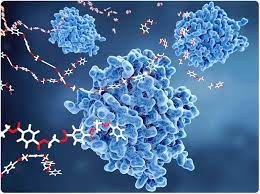NanoPtA : Nanozyme

Researchers at the Indian Institute of Science (IISc) have developed a novel enzyme mimic called NanoPtA, with significant potential applications in wastewater treatment and healthcare.
- In this study, the IISc team synthesized NanoPtA, a platinum-containing nanozyme that can be converted into a powder for industrial use.
- NanoPtA exhibits the ability to degrade toxic chemicals in industrial wastewater effectively when exposed to sunlight.
- When NanoPtA comes into contact with wastewater, it forms tape-like structures through non-covalent interactions between benzene rings and long alkyl chains in the molecules.
- These structures emit light, which enables them to oxidize pollutants in the presence of sunlight, reducing wastewater toxicity.
- The researchers found that NanoPtA could rapidly degrade common pollutants like phenols and dyes, even at low concentrations, within ten minutes under sunlight.
- Beyond wastewater treatment, scientists believe that NanoPtA has potential applications in healthcare.
- It could serve as a valuable diagnostic tool for neurological and neurodegenerative diseases, showcasing its versatility and significance in multiple fields.
Nanozymes:
- They are nanomaterials that possess enzyme-like properties. Unlike natural enzymes, which are typically proteins, nanozymes are typically made of inorganic materials such as nanoparticles.
- These nanostructures can catalyze chemical reactions in a manner similar to enzymes




